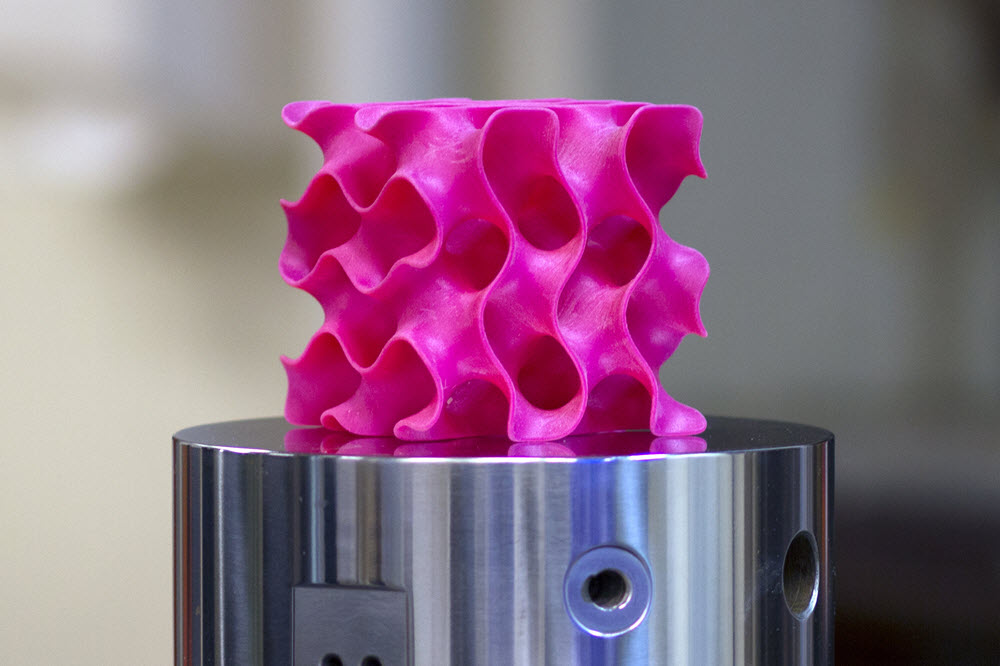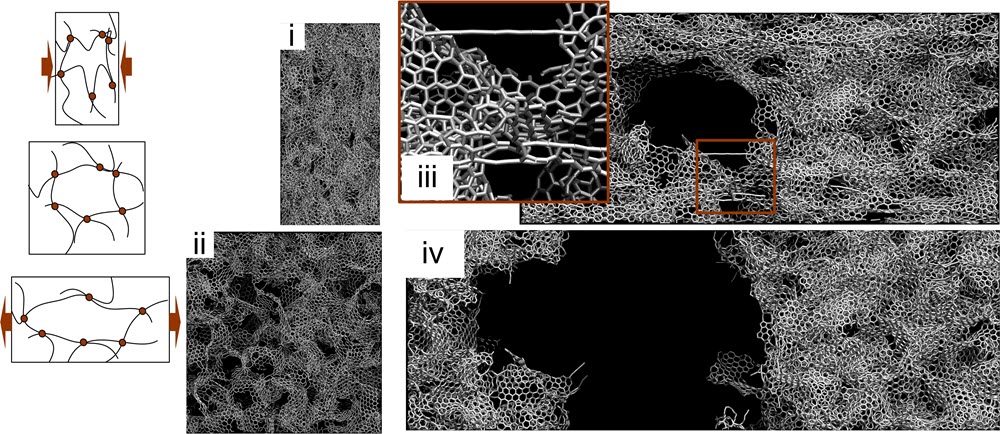MIT researchers design one of the strongest, lightest materials known
January 6, 2017

3-D-printed “gyroid” models such as this one were used to test the strength and mechanical properties of a new lightweight material (credit: Melanie Gonick/MIT)
MIT scientists said today they’ve just created one the strongest materials known (ten times stronger than steel, but also one of the lightest, with a density of just 5 percent of that of steel) by compressing and fusing flakes of graphene, a two-dimensional form of carbon.
In its two-dimensional form, graphene is thought to be the strongest of all known materials. But researchers until now have had a hard time translating that two-dimensional strength into useful three-dimensional materials.
It’s all about the geometrical configuration
But it’s not about the material itself; it’s about their unusual 3-D geometrical configuration, the researchers discovered. That suggests that similar strong, lightweight materials (in addition to graphene) could be made from a variety of materials by creating similar geometric features.
“You can replace the material itself with anything,” says Markus Buehler, the head of MIT’s Department of Civil and Environmental Engineering (CEE) and the McAfee Professor of Engineering. “The geometry is the dominant factor. It’s something that has the potential to transfer to many things.”
The findings were reported today an open-access paper in the journal Science Advances.

This illustration shows the simulation results of compression (top left and i) and tensile (bottom left and ii) tests on 3-D graphene (credit: Zhao Qin)
By analyzing the material’s behavior down to the level of individual atoms within the structure, the engineers were able to produce a mathematical framework that very closely matches experimental observations.
Two-dimensional materials — basically flat sheets that are just one atom in thickness but can be indefinitely large in the other dimensions — have exceptional strength as well as unique electrical properties. But because of their extraordinary thinness, “they are not very useful for making 3-D materials that could be used in vehicles, buildings, or devices,” says Buehler. “What we’ve done is to realize the wish of translating these 2-D materials into three-dimensional structures.”
The trick: heat + pressure
The solution for compressing small flakes of graphene turned out to be a combination of heat and pressure. This process produced a strong, stable structure whose form resembles that of some corals and microscopic creatures called diatoms. These new shapes, which have an enormous surface area in proportion to their volume, proved to be remarkably strong.
Buehler says the process resembles what would happen with sheets of paper. Paper has little strength along its length and width, and can be easily crumpled up. But when made into certain shapes, for example rolled into a tube, suddenly the strength along the length of the tube is much greater and can support substantial weight. Similarly, the geometric arrangement of the graphene flakes after treatment naturally forms a very strong configuration.
Melanie Gonick/MIT | One of the strongest, lightweight materials known
Other applications
But many other possible applications of the material could eventually be feasible, the researchers say, for uses that require a combination of extreme strength and light weight. “You could either use the real graphene material or use the geometry we discovered with other materials, like polymers or metals,” Buehler says, to gain similar advantages of strength combined with advantages in cost, processing methods, or other material properties (such as transparency or electrical conductivity).
The unusual geometric shapes that graphene naturally forms under heat and pressure look something like a Nerf ball — round, but full of holes. These shapes, known as “gyroids,” are so complex that “actually making them using conventional manufacturing methods is probably impossible,” Buehler says.
The team used 3-D-printed models of the structure, enlarged to thousands of times their natural size, for testing purposes. For actual synthesis, the researchers say, one possibility is to use the polymer or metal particles as templates, coat them with graphene by chemical vapor deposit before heat and pressure treatments, and then chemically or physically remove the polymer or metal phases to leave 3-D graphene in the gyroid form.
The same geometry could even be applied to large-scale structural materials, they suggest. For example, concrete for a structure such a bridge might be made with this porous geometry, providing comparable strength with a fraction of the weight. This approach would have the additional benefit of providing good insulation because of the large amount of enclosed airspace within it.
Because the shape is riddled with very tiny pore spaces, the material might also find application in some filtration systems, for either water or chemical processing. The mathematical descriptions derived by this group could facilitate the development of a variety of applications, the researchers say.
The research was supported by the Office of Naval Research, the Department of Defense Multidisciplinary University Research Initiative, and BASF-North American Center for Research on Advanced Materials.